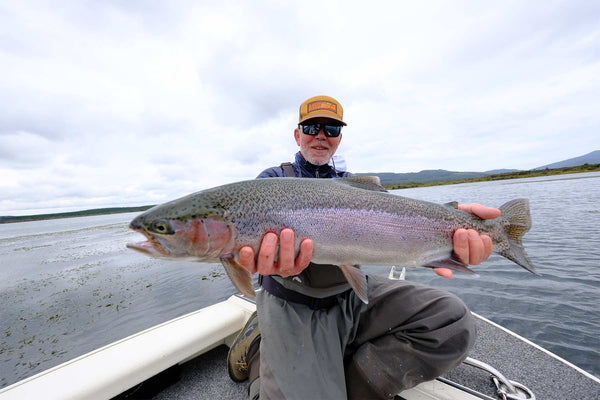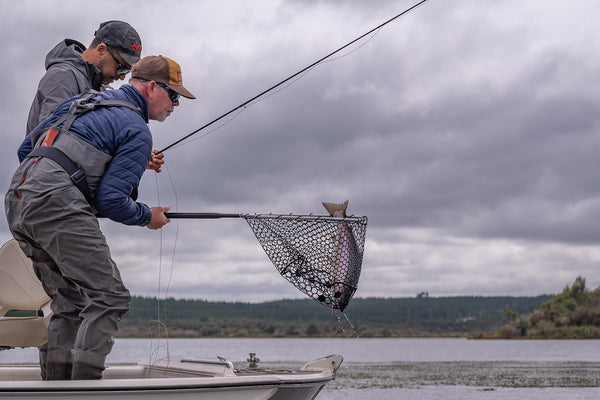Fly Fishing Tackle For Stillwaters-Lakes

The main question to answer is whether a product is appropriate for the types of fly fishing the angler wants to do. An example we all understand here in New Zealand is when visiting anglers come equipped with a light 3 or 4 weight spring creek rod with the mindset of targeting our back country trout. As it turns out the angler then tries to use his or her 4 weight to cast heavy tungsten nymphs on an invariably windy day.
Conversely, if that angler were to take the 4 weight fly rod to fish many of the small Waikato streams with small dries and light nymphs they would find their outfit perfect and be met with greater success. The point being the issue here is not quality of tackle but appropriateness to the type of fly fishing we are wanting to do.

The question of appropriateness is particularly important when it comes to tackle for still water fly fishing. As a whole, the vast majority of tackle we have available to us in New Zealand is designed and stocked by retailers for river fishing, and this is understandably so, as by and large the vast majority of angler hours are spent on our river systems versus our lake and reservoir fisheries. Although most river tackle will be effective when fished on stillwaters, there are now a number of specific products that can make stillwater fly fishing more productive.

When it comes to rods for still waters the primary variable that changes is rod length. By and large, (with the exception of Czech nymphing rods) fly rods made for rivers are 8’6” to 9’0”, and rods designed for small bushy streams lie between 7’0” and 8’0”. In contrast, specialist still water rods are longer; between 9’6” and 10’0” in length. This extra length is quite beneficial in a number of ways; firstly a longer rod gives you extra clearance when casting. The Primal RAW CCC freshwater range covers all the lengths described above.
This helps when deep wading from the bank or when casting from a boat, giving you more clearance over obstacles in the boat and more importantly your mates head. Secondly, longer rods make it easier to handle long leaders, especially with multiple fly rigs. This is particularly important when still water fishing as flies tend to be far more spread out on the leader than when river fishing. Thirdly, longer rods improve line control. From the bank this helps when casting over weed beds where a longer rod can help swing the flies over the back of the drop off rather than dragging them directly into the weed.
Similarly on the boat, the longer rod aids in hanging the flies further from the boat. Lastly one of the advantages of longer rods is that due to their very nature they tend to be much stiffer in the butt than their shorter cousins; this aids in casting heavy sinking lines and fighting fish. It also tends to mean lighter line weights can be fished with relative effectiveness as you may no longer require an 8 weight rod to fight the fish as a 10’0” 5 weight or 6 weight rod will have the same amount of power in the butt.

Image - Nick Raygaert
When it comes to reels, although I’m a big fan of nice reels, it’s hard to justify a high cost reel plus half a dozen spools to carry all of the lines you’ll need for still water fishing. One of the best solutions is a cassette style reel where the spare cartridges are far cheaper than complete spare spools. Understanding that trout and their food are positioned both horizontally and vertically in the water in front of you is paramount to effectively fishing a large lake.
When it comes to fishing through the water column there is no piece of equipment more important than the fly line. Starting from the top of the water column, floating fly lines are perfect for fishing shallow water and the clear advantage over their sinking counterparts is that they are easier to pick up and re-cast. Fine presentation tapers are perfect for stalking fish around lake edges but for most other applications they lack the power to turn over the long leaders often required for stillwaters. Consequently more aggressive tapers are often a better choice for stillwater fishing.

The first sink rate available on the market is a slow intermediate. These lines tend to sink at around half an inch per second. By and large with a slow intermediate the flies won’t be fishing a lot deeper than with a floating line. The primary advantage is that the line will break through the surface and not be blown into an arc by the wind nor will it be driven up and down by the waves. The result is the angler will be in more direct contact with the flies than when fishing a floating line. And direct contact is the key to feeling subtle takes when lake fishing.
The next sink rate is the fast or clear intermediates. Those with braided cores tend to be coloured as the core itself is white so it’s impossible to make a clear line, in contrast clear intermediates with a monofilament core can be made clear.

The obvious advantage of a clear line is stealth, however due to their monofilament core these lines do tend to be quite stretchy making it harder to feel takes. Where the clear lines are at their best is when stalking cruising fish in clear lakes. The intermediate line will not cast the same shadow as a floating line will and the clear line is just like fishing a very long leader.
In contrast the coloured intermediates are better for contact fishing, where you can’t see the fish take the fly. Overall the advent of non-stretch cores on modern sinking lines is by far the biggest technological breakthrough to improve stillwater angler’s success rate. Traditionally fly lines stretch in excess of 20%; the problem with this is when fishing at any reasonable length it is impossible to feel subtle takes. Sure, you’ll hook the fish that swallows the fly or you’ll feel the odd aggressive take, but what you won’t feel is a fish taking a nymph and the line slightly coming tight or a fish picking up the flies as they sink after you’ve made your first cast.

Moving down the sink rates, high density lines from Di-3 and Di-5 through to the ultra fast Di-7 all play an important part in getting flies down into the fishing catching zone. As a rule of thumb the faster you are going to retrieve your flies the faster sink rate line you are going to require; also obviously the deeper the water is the faster the line you are going to want. In addition to the sink rate of the fly line the next option is whether to go for either a full sinking line or a shooting head style line.
By and large full sinking lines offer more control versus a shooting head that will offer more distance. When it comes to fishing teams of multiple flies and for fishing from a drifting boat, a full sinking line is best. Where shooting heads are useful is when fishing one or two flies off the bank or when fishing a drop off from a boat; particularly when there is current such as the Tongariro Delta. In this situation the thin running line creates less of a bow in the current than a full sinking line would and consequently the angler will feel more takes and control the fly better. The 40+ lines are made with a shooting head smoothly joined into an appropriate running line and are specifically designed for stillwater fly fishing.

Traditional sink tip lines have by and large been replaced in the market by polyleaders that are marketed by a number of brands. These polyleaders come in a variety of sink rates that allow anglers to create their own sink tip fly lines by attaching the leaders onto a floating line. What’s more, the ability to change a polyleader quickly enables anglers to alter the depth they are fishing within minutes. As these leaders act like an extension to your fly line they help to turn over long casts and are less likely to ‘dump’ when the wind starts to pick up.
On from the polyleaders there are a number of different options for tippet materials. Most anglers these days prefer fluorocarbon as it turns over well and is more durable. I would certainly agree with this sentiment and for all of my sub-surface fishing I tend to use fluorocarbons, however when fishing dry flies even on stillwaters, co-polymers will create less drag on the flies, allowing them to bounce around in the waves more naturally.
When it comes to what to tie on, well, there's enough there for another dozen articles. Why not start with a quick wander through the Manic Fly Collection stillwater nymphs?

One thing is for sure in New Zealand & Australia is that we have a large cross section of stillwaters available to us. All of which present their own challenge to the fly fisher and although much of this fishing can be done adequately with the tackle you currently own, many new possibilities can be opened up by the vast array of specialist stillwater equipment available to today’s angler. By utilising and learning to understand different lines, and longer rods the world of stillwater angling can be just as adventurous as our beloved rivers; you just may need a larger tackle room to store it all.

